Clincher vs Tubular vs Tubeless Tires — All Differences Explained
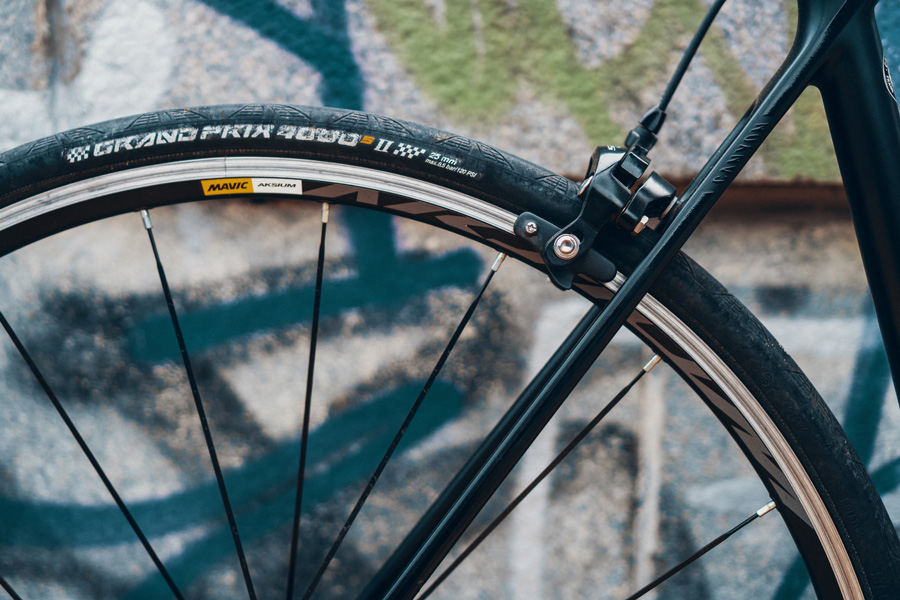
Cyclists endlessly debate which tire system is the best: tubeless, tubular, or clincher. Choosing the perfect type seems complex due to the numerous variables to consider, such as comfort, weight, puncture resistance, price, convenience, and speed.
Each design has advantages and disadvantages, so the rider’s tire choice depends on which characteristics are most relevant to their preferred riding style. Competitive amateurs, professionals, and weekend warriors have vastly different needs and preferences, as does each discipline.
This article will describe each tire, its characteristics, and the pros and cons, so you can make an informed choice on your tires to get the most out of your rides.
Clinchers, Tubulars, and Tubeless Tires Explained

As mentioned, there are three distinct tire designs that you can choose from. The three tires are constructed with similar materials, and they function similarly, relying on an air chamber with an outer layer of rubber set on a wheel rim. The most significant differences between systems are the rim design and how they seal air.
Rims/Wheels
Tubular wheels are the most distinct, pairing only with tubular tires because they don’t have a bead seat (hook) for a clincher tire to attach. Instead, they use glue or tape to connect the tubular tire to the smooth rim surface.
Conversely, tubeless-ready and clincher wheels have bead seats (hooks)—ridges on the rim wall that interlock with the tire bead hooks. As a result, both clincher tires and tubeless tires function on tubeless-ready rims.
However, tubeless tires won’t work on clincher rims unless you convert them (described below). The main difference between the rims is the size and shape of the hooks; tubeless-ready bead seats are higher and shaped slightly differently to ensure an airtight seal.
What Is a Clincher Tire?

Continental Grand Prix 5000 clincher tire.
A clincher setup consists of a clincher-specific tire, tube, and either a clincher rim or a tubeless-ready rim. The tire casing and thread, made primarily of rubber, is lined with two hoops around the edge called the bead. This bead is usually steel wire or another strong but lightweight material like Kevlar.
Clinchers inflate using a rubber tube inside the tire chamber. The tire bead hooks into the bead seat and seals once you pump up the inner tube, creating a solid, enclosed space.
Clinchers are widespread thanks to the low prices and ease of repair and replacement, allowing quick and easy roadside changes. In addition, there is a massive range of brands producing various models of rims, tires, and tubes, making them easy to find. But unfortunately, their design also makes them susceptible to punctures.
What Is a Tubular Tire?

Continental Competition Tubular Tire.
Like clinchers, tubular tires (a.k.a sew-ups or tubs) also use a tube to inflate the air chamber. However, instead of the tube remaining separate, it is sewn into the tire casing and sealed inside. Then, to connect the tire to the rim, you must use specialized tape or several coatings of glue.
As tubulars don’t have a bead, they are much lighter than the alternatives, making them highly popular with professional cyclists. Additionally, you can run more varied tire pressures. Thanks to supple materials and lower PSI, tubular ride quality is notably smoother and more comfortable.
Another advantage is that they are less susceptible to pinch flats and lose air slowly once punctured, allowing racers to keep going until a service car reaches them.
The issue with tubular tires is repair and replacement. It’s very tricky to do roadside repairs as you must replace the tire and stick it onto the rim with glue or tape, which is labor-intensive and requires experience to get it right. Another reason why professionals enjoy using them is they don’t have to replace the tires.
What Is a Tubeless Tire?
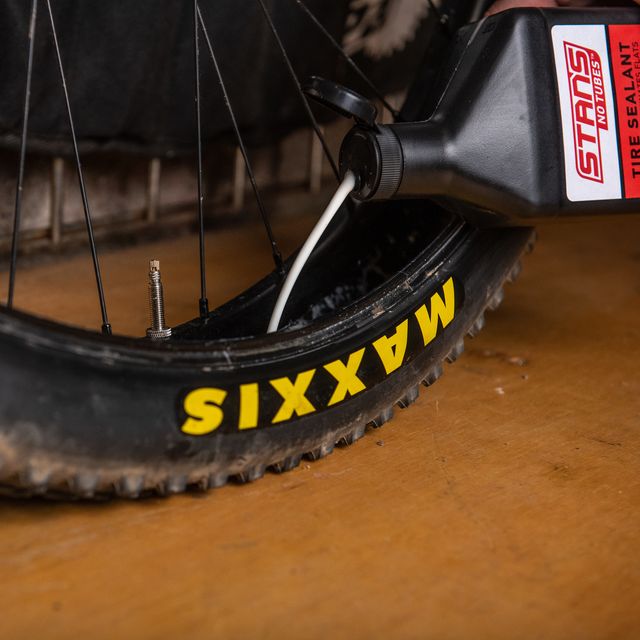
A tubeless tire is similar to a clincher, but it has a stronger bead and holds sealant instead of a tube. | Image source: Stan’s NoTubes
Tubeless tires are the newest addition to the market. They are widely used in mountain biking disciplines and are slowly gaining popularity in road and cyclocross disciplines, with the first World Tour road racing team using the technology in 2020.
The tubeless rim, as mentioned above, is similar to the clincher except with a more pronounced bead seat and the different shapes that interlock better. Tubeless tires are more robust than clincher tires as they use an extra layer of rubber in the casing or tire sealant to protect against punctures. The tire sealant, once pierced, automatically solidifies to block small holes.
This design has various pros and cons. First, pinch punctures are far less common, which is extremely valuable to off-road riders. Second, you can run tubeless tires on much lower PSIs than clinchers, providing more grip and superior comfort through shock absorption.
Unfortunately, tubeless tires are the heaviest of the three (only slightly heavier than clinchers), and the sealant makes them messy to repair on the road, although not quite as bad as tubulars. That said, you can use a standard tire tube for roadside repair if necessary. Finally, they cost more than the other two types and can be tricky to set up.
The Differences Between Clinchers vs. Tubulars and Tubeless Tires

A cross-section showing the difference between clincher, tubeless, and tubular tires. | Image source: Hunt Bike Wheels
It’s necessary to know what characteristics you are looking for and which you value the most. Then you can make the right choice between a tubeless or standard clincher vs. tubular tire. For non-competitive riders, the decision comes down to tubeless vs. clincher simply because of the inconvenience of maintaining tubulars.
However, tubular tires are still widely considered the best for road racers.
Mounting Process
Clincher tires are without doubt the easiest and fastest to mount. This convenience is why they are the most popular type of tire on the market and are likely to remain so.
Tubeless tires are complex to set up initially as you ensure the whole system is airtight and the sealant is added and spread evenly. Although it’s possible to repair your tubeless tires on the road if you get a puncture that the sealant doesn’t fix, it’s more complex and time-consuming than standard clinchers.
No posts for this criteria.Tubular tires take the most time to mount as they require a special glue painted on with two to four coatings, allowing a day to dry in between each coating. Once the last layer is on, the tire requires a final coating before being placed on the rim.
A quicker but less durable method is to use “tub tape,” essentially replacing the need for glue by lining the inside of the rim with adhesive tape. In addition, both tubular mounting methods require thorough cleaning of the rim with a degreaser before installation.
Puncture Protection

Tubeless tires are the least susceptible to punctures thanks to the ability to run a low PSI, the use of sealant inside to self-repair minor holes, and because they don’t rely on the weak inner tube. In general, clincher and tubular tires are more susceptible to punctures than tubeless; however, tubulars experience fewer punctures than clinchers.
Tire material choice also significantly affects puncture protection, as many brands have puncture-resistant lines, such as Continental’s Gatorskin tire or Schwalbe’s Greenguard technology. Puncture protection typically adds more weight, so these tires are primarily for commuter bikes, touring bikes, and mountain bikes where weight isn’t an issue but durability is essential. In general, road tires don’t have any puncture resistance.
Weight
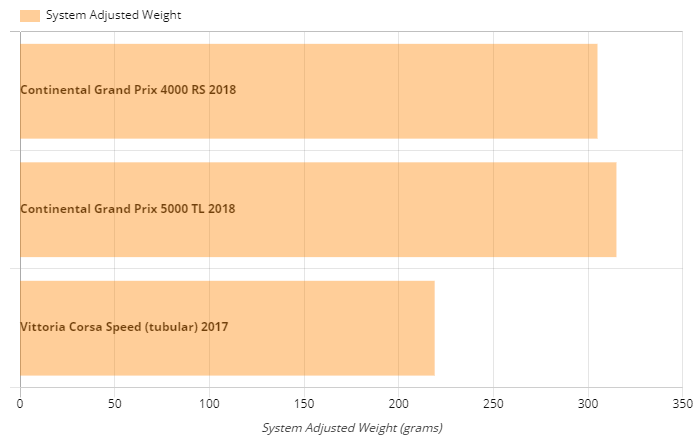
System-adjusted bike tire weight comparison. | Image: bicyclerollingresistance.com
Tubulars are the lightest tire available by a significant margin. For this reason, they are and will remain the most popular choice for racers. When comparing clincher vs. tubeless, there is minimal difference in weight between equivalent models.
Within the categories, weight varies depending on price and whether or not puncture protection is used. Cheaper tires are heavier, less comfortable, rigid, and usually more susceptible to puncture.
The higher the price, the more advanced the manufacturing technology, helping keep the weight down unless that specific tire has puncture-resistant materials.
Pricing
Clinchers are the cheapest option on the market. A good-quality road tire, rim, and tube can cost as little as $100. Their widespread and long-term use means there is a lot of competition between brands to keep prices relatively low.
Comparatively, tubular and tubeless tires are expensive. Most tubulars are performance-oriented, which keeps the price high, but there are some low-price options; they’re just harder to find. Likewise, the rims are expensive as they are primarily aimed at the racing market.
Tubeless tires are the most expensive but are becoming cheaper as they grow in popularity and the technology improves. Additionally, there are lower recurring costs as the tires are more durable and don’t require tubes.
Speed and Rolling Resistance
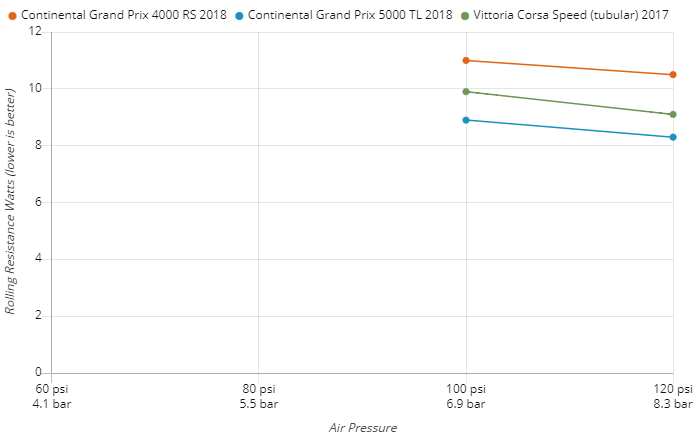
Rolling resistance compared between a clincher, tubeless, and tubular tire. | Image: bicyclerollingresistance.com
The difference in speed between the three tire types is negligible for the average, non-competitive rider. However, tubeless tires seem to be the fastest, thanks to a slight reduction in rolling resistance. In the middle are clinchers, and surprisingly, the slowest kind is tubular tires, despite being widely used among professionals.
The team at Cycling Weekly undertook this experiment and determined the following rolling resistance measurements based on their 191lb test cyclist riding at 24.85mph.
- Tubeless – 25 watts of rolling resistance
- Clincher – 28 watts of rolling resistance
- Tubular – 30 watts of rolling resistance
The extra resistance is likely due to additional friction within the systems. For example, clincher tires have an inner tube that adds friction compared to tubeless ones. However, tubulars have an inner tube plus glue or tape, adding even more friction.
Range of Products
Clinchers are the most common, with several brands on the market, each with a wide range of designs and price levels. In addition, there are equally large numbers of inner tubes and rims. Inner tubes are made with rubber butyl (standard or lightweight) or latex. Latex is light but not durable, standard butyl is heavy and durable, and lightweight butyl sits in the middle.
Schwalbe Tires Review
Regarding the range of products, tubular vs. tubeless are more or less equal. However, tubeless tires have surged in popularity in recent years, with many high-end bikes using tubeless-ready tires as a standard. Meanwhile, tubulars are only used among competitive cyclists. As a result, tubeless is now more widespread, with better selections than tubular.
Tread Per Inch
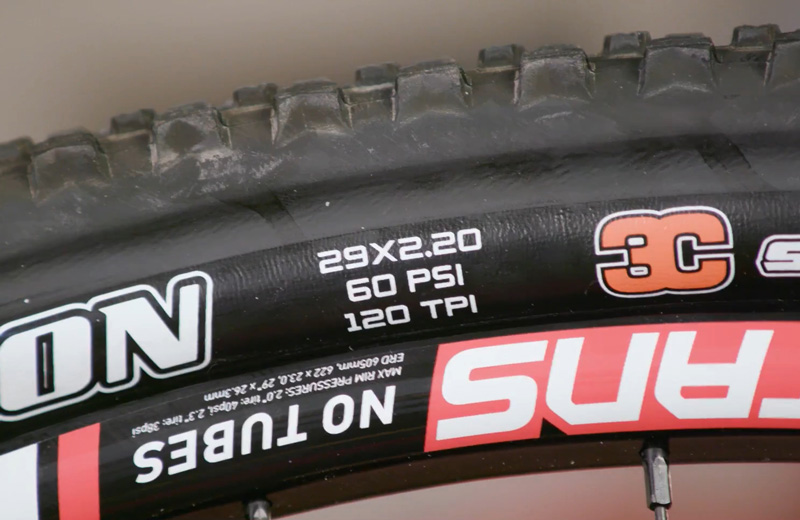
Thread per inch (TPI) relates to all three tires types. TPI indicates how fine the threads are and the resulting characteristics; higher-quality tires typically have higher TPI ratings.
The higher the TPI, the more supple and responsive the tire is. This suppleness allows the tire to respond to small bumps by flexing instead of bouncing, resulting in a smoother, more comfortable ride quality. Conversely, low-TPI tires are more rigid and typically less comfortable.
Can You Convert Clincher Wheels to Tubeless?
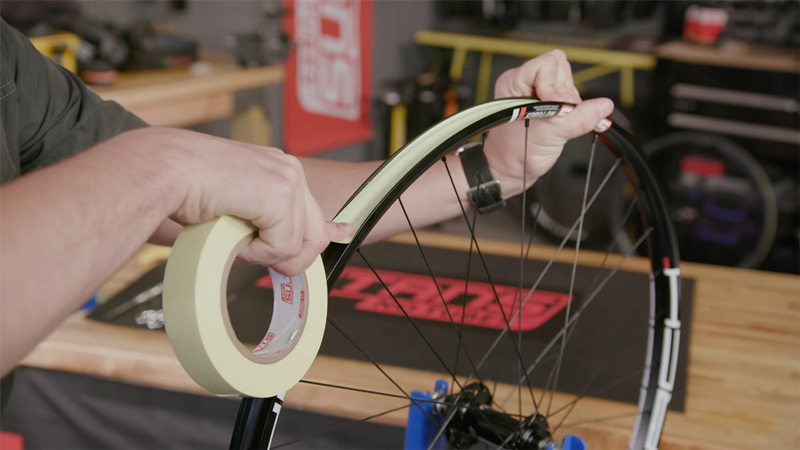
With ample amounts of tubeless tapes, it’s possible to convert a clincher wheel to tubeless. | Image source: Notubes.com
It is possible to convert clincher wheels into tubeless wheels using basic equipment. Although you can do it, it isn’t guaranteed to work, as sometimes the tire bead won’t seal fully against the bead seat. You need tubeless rim tape, tubeless tires and bike tire valves, and sealant to do the conversion.
Then, you can choose any of the follow-along videos available online for instructions on how to convert your clincher wheels to tubeless.
Choosing the Right Type for You
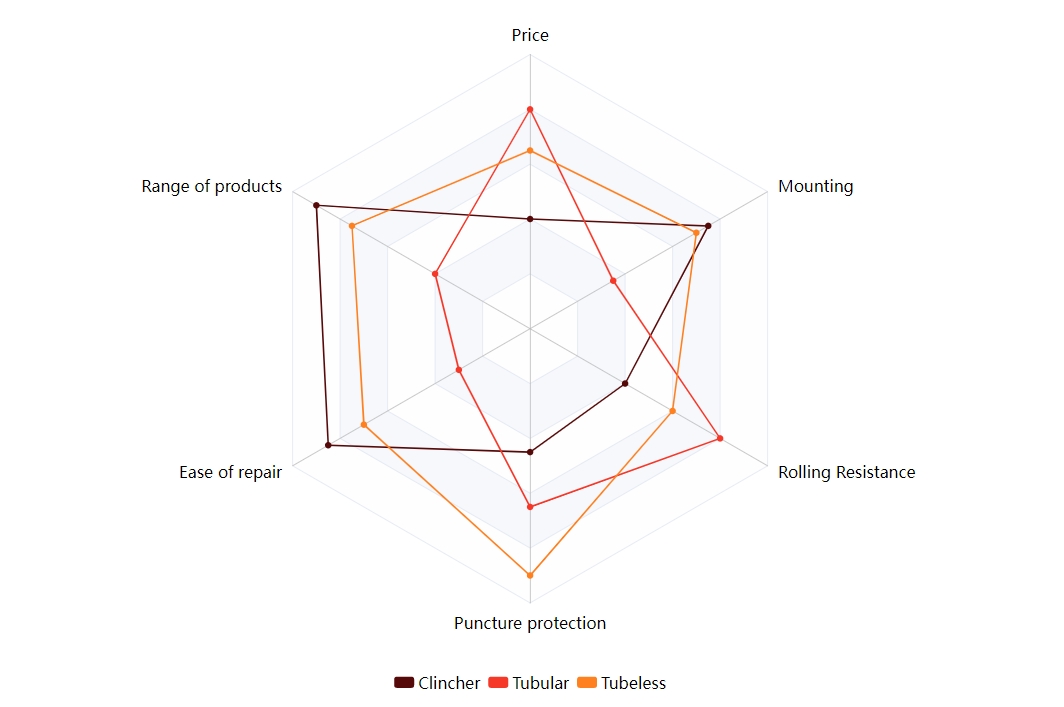
Picking the perfect type of tire for your preferred riding style isn’t too hard once you understand the advantages of each one.
Clinchers are the perfect choice for most casual riders, thanks to the enormous range of products, prices available, and the simplicity of roadside repair and replacement. It’s easy to find precisely the spec you are looking for, too, be it durable puncture-resistant city tires or lightweight race-ready ones.
In addition, most bikes come with clincher or tubeless-ready rims as a standard, so you don’t have to replace them.
Tubular tires are still the go-to choice for almost all competitive road and cyclocross riders, given the significant weight savings and ability to use a wider range of tire pressures. Another reason these tires are so popular is that professional teams have several mechanics who can repair and replace the tires, an extremely time-consuming task.
Finally, tubeless tires are almost ubiquitous in amateur and professional mountain biking because their strengths are ideal for off-road bikes as well as for gravel bikes. The main benefits of tubeless are the puncture resistance and the ability to run super-low PSIs.
In addition, we’ve seen that they also offer the lowest rolling resistance, although only slightly. With time, improved pricing, and better technology, we believe other disciplines will start to favor tubeless over clinchers.




How about tubeless sealant in tubular tires? Any pros and cons you can offer?
Hi Char!
You can definitely use tubeless sealant in tubulars as racers often use it for the extra protection, but casual riders might not find it as necessary.
It can help seal small punctures, but it won’t fix everything, adds a bit of weight, and can get messy if not done properly.
Also, you should do more research about your tires, as some tubulars might not be fully compatible with sealants.
That’s an amazing article. This comprehensive article will answer everything I need to know about each tire type. Will follow all articles.
Thanks, Dalton!